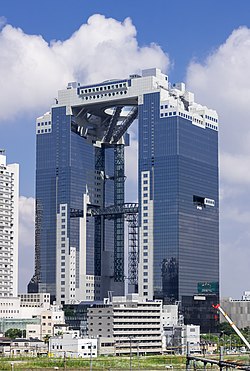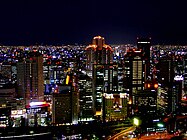Umeda Sky Building
34°42′19″N 135°29′23″E / 34.70528°N 135.48972°E
| Umeda Sky Building | |
|---|---|
梅田スカイビル | |
 | |
 | |
| General information | |
| Location | Osaka Prefecture, Japan |
| Completed | March 25, 1993 |
| Owner | Sekisui House |
| Height | |
| Antenna spire | 190 metres (623.4 ft) |
| Roof | 170 metres (557.7 ft) |
| Technical details | |
| Floor count | 40 floors above ground, 2 floors underground |
| Floor area | 147,397 square meters |
| Design and construction | |
| Architect(s) | Hiroshi Hara[1] |
| Main contractor | Takenaka Obayashi Kajima Asunaro Aoki Common enterprise |
The Umeda Sky Building (梅田スカイビル, Umeda Sukai Biru) is a two-tower mixed-use skyscraper located in Osaka, Japan. Located in the outskirts of Umeda business district in Kita-ku, Osaka, the Umeda Sky Building consists of two 40-story towers that connect at their two uppermost stories, which are interconnected via glass bridges with escalators and elevators which crosses the tower's open atrium space in the ground floor area.[2] It is currently the fifteenth-tallest building in the prefecture, and is one of the city's most recognizable landmarks.[3]
The towers reached a total height of 170 m (557.74 ft) while the overall height of the tower including the towers' spires is at 190 metres (623.4 ft).[4] The towers were designed by Hiroshi Hara,[1] and was constructed by Takenaka Corporation[5] and was completed in 1993.[6]
History, Design Concept & Construction
[edit]The building was originally conceived in 1988 as the "City of Air" project, a planned mixed-use skyscraper which was envisioned to create four interconnected towers in northern Osaka, located within the Umeda central business district and is at close proximity to the Yodo River. The third tower of the complex was initially planned to be constructed within the current site of the Vegetable Garden, while the fourth tower was planned located along the eastern side of the third tower. Eventually, the Japan economic bubble of the 1980s caused widespread damage to the Japanese economy and brought the total number of towers down to two towers.[7]
During the architectural planning of the complex, Hiroshi Hara created the overall concept of the towers are based on two key concepts: the first concept was to create a modern landmark in the city featuring modern architecture, and drew inspiration from the Grande Arche in Paris, France, which features a hypercube-like design. The second concept within the complex is to emphasize a vision of a "floating city", which can be reflected from the city's urban landscape and is contrasted with the opaque ceramic atrium at the ground floor. The concept also included open-air like amenities and viewing decks of the Umeda district and the entire Osaka Skyline in three dimensions.[8]
The towers' construction process started with the construction of the twin towers using reinforced concrete, while the construction of the sky deck began afterwards. As the structural works of the towers were completed, the sky deck was raised to the ground using the lift-up construction method, which used a set of hydraulic elevators to raise the section upwards, and is the first time to be introduced within a construction project. The installation of the glass-layered escalators and elevators also followed the same system. The tower was fully completed and began opening its doors to the public on March 25, 1993.[5]
Location
[edit]The two-tower skyscrapers sits within the Shin-Umeda City, a 4.34-hectare (10.7-acre) mixed-use area which includes The Westin Osaka, and the Shin Umeda City General Information Center.[9] [10] It is also located near key transport hubs such as the Ōsaka Station and the Umeda Station, both of which serves as one of the most busiest railway stations in both Japan and the world.[11]
Features
[edit]The building primarily highlights a rooftop observatory, named the Kuchu Teien Observatory, which is also known as The Floating Garden Observatory.[12] The two-floor observatory serves as the towers' main attraction and also features Café Sky 40 and the Fence of Vows.[7] The tower also has an underground market that attempts to recreate the atmosphere of Osaka in the early 20th century.[13] The base of the towers also presents two sets of urban gardens with walking trails and water features, namely the Island Garden, and the Vegetable Garden.[9]
Ownership
[edit]The building was mainly owned by Toshiba Corporation through Toshiba Building Co., Ltd. In July 2008, Toshiba sold a majority stake (65%) in Toshiba Building to Nomura Real Estate co. but maintains a 35% ownership.[14]
Tenants
[edit]Sekisui House, which serves as the complex's owner and developer, serves as the main tenant of the tower, and serves as the company's headquarters. Mazda has an office in the Umeda Sky Building Tower East.[15] The German consulate-general is located on the thirty-fifth floor of the Umeda Sky Building Tower East.[16] AstraZeneca have their Japanese and Asia-Pacific headquarters in the East Tower.[citation needed] PlatinumGames is also located in the building.[17]
Gallery
[edit]-
View looking up
-
The escalator crossing the wide atrium-like space
-
Night view from Umeda Sky Building
-
Dusk view from Umeda Sky Building
-
The view of the three towers within the Shin-Umeda City complex, the Westin Umeda and the Umeda Sky Building
-
A view of the glass-layered escalator crossings from the Sky Deck
See also
[edit]References
[edit]- ^ a b Hiroshi Hara, Terasaki Center for Japanese Studies, UCLA, accessed May 13, 2023.
- ^ "Umeda Sky Building". GoJapanGo. Retrieved 2008-10-19.
- ^ List of tallest structures in Osaka Prefecture
- ^ "Umeda Sky Building". Japan Guide. Retrieved 2008-10-19.
- ^ a b "Shin Umeda City/Umeda Sky Building". www.takenaka.co.jp.
- ^ "Outline of Shin Umeda City". Sky Building. Retrieved 2008-10-19.
- ^ a b "Dramatic Architecture and Views at Osaka's Umeda Sky Building". nippon.com. 28 November 2016.
- ^ "✅ Umeda sky building - Data, Photos & Plans". WikiArquitectura.
- ^ a b "Shin Umeda City General Information Center". OSAKA INFO.
- ^ "Shin-Umeda City". The KANSAI Guide - The Origin of Japan, KANSAI. 21 January 2023.
- ^ "Japanese Train Stations - Japan By The Numbers". Samurai Tours. 14 July 2019.
- ^ "Umeda Sky Building". www.japan-guide.com.
- ^ Sy, Hannah (2014-10-29). "Takimi Koji Underground Eat Street - Osaka". JapanTravel. Retrieved 2024-01-23.
- ^ Nomura Real Estate Holdings, Inc. and Toshiba Corporation to Establish Alliance in Real Estate Business through Sale of Majority Ownership of Toshiba Building Co., Ltd.
- ^ "Offices Archived 2009-10-07 at the Wayback Machine." Mazda. Retrieved on October 29, 2009.
- ^ "List of Consulates in Kansai Area Archived 2008-09-23 at the Wayback Machine." Creation Core Higashi Osaka. Retrieved on January 15, 2009.
- ^ "Inside Platinum Games: we chart the history and future of the studio behind Bayonetta." Retrieved on October 19, 2014.
External links
[edit]- Umeda Sky Building, Sekisui House Umeda Operation Co.
- Outline of Shin Umeda City, Sekisui House Umeda Operation Co.
- Umeda Sky Building, Takenaka Corporation
- Umeda Sky Building, Japan Guide






